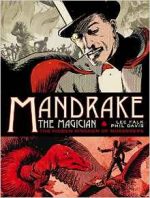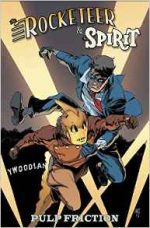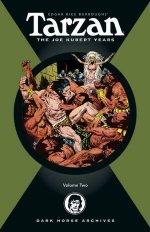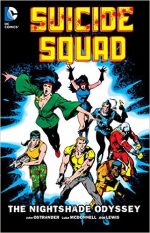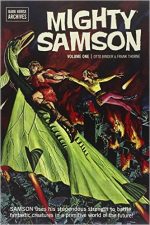
By Otto Binder & Frank Thorne & various (Dark Horse Comics)
ISBN: 978-1-59582-579-7
These days all the attention in comics circles goes to the big-hitters and headline-grabbing groundbreakers, but once upon a time, when funnybooks were cheap as well as plentiful, a kid (whatever his or her age) could afford to follow the pack and still find time and room to enjoy quirky outliers: B through Z listers, oddly off-kilter concepts and champions far falling outside the accepted parameters of standard super-types…
A classic example of that freedom of expression was the relatively angst-free dystopian future of Mighty Samson, who had a sporadic yet extended comics career of 32 issues spanning 1964 to 1982.
Although set in the aftermath of an atomic Armageddon, the story of the survivors was a blend of updated myth, pioneer adventure and superhero shtick, liberally leavened with the kind of incredible creatures and sci fi monsters the industry thrived on back then.
As a publisher, Gold Key never really “got†the melodramatic, often-mock-heroic Sturm und Drang of the 1960s superhero boom – although for many of us, the understated functionality of classics like Magnus, Robot Fighter and Dr. Solar, Man of the Atom or the remarkably radical concepts of atomic crusader Nukla and crime-fighting iterations of classic movie monsters Dracula, Frankenstein and Werewolf were utterly irresistible. The sheer off-the-wall lunacy of features like Neutro or Dr. Spektor I will save for a future occasion…
This superb first full-colour hardback compilation – printed on a reassuringly sturdy and comforting grainy old-school pulp stock rather than glossy paper – gathers the first half dozen issues of Mighty Samson, as anonymously created by industry giants Otto Binder & Frank Thorne. It even includes some monochrome single-page fact-features and the mesmerising painted covers by unsung master illustrators Morris Gollub and George Wilson.
These covers were reproduced text-free on the back of each issue and probably graced many a kid’s bedroom wall way back when. You get those too, but I’d suggest scanners rather than scissors this time around…
Otto Binder was a quintessential jobbing writer. He and his brother Earl were early fans of science fiction and made their first professional sale to Amazing Stories in 1930. As “Eando Binder†their pulp-fiction and novels output ran well into the 1970s, with Otto rightly famed for his creation of robotic hero Adam Link.
From 1939 onwards, Otto was also a prolific comicbook scripter, most beloved for the invention and perfection of a humorous blend of spectacular action, self-deprecating humour and gentle whimsy which characterised the Fawcett Captain Marvel line of characters (and later DC’s Superman’s Pal Jimmy Olsen). He was also constantly employed by many other publishers and amongst his most memorable inventions and innovations are Timely’s Young Allies, Mr. Mind, Brainiac, Krypto the Super Dog and the Legion of Super-Heroes.
In his later life he moved into editing, producing factual science books and writing for NASA.
Frank Thorne is one of the most individualistic talents in American comics. Born in 1930, he began his comics career drawing romances for Standard Comics beside the legendary Alex Toth before graduating to better paid newspaper strips: illustrating Perry Mason for King Features Syndicate. For Dell/Gold Key he drew Flash Gordon, Jungle Jim and The Green Hornet, as well as the first few years of this seminal sci-fi classic.
At DC he did compelling work on Tomahawk and Son of Tomahawk before being hired by Roy Thomas at Marvel to illustrate his belated breakthrough strip Red Sonja. Forever-after connected with feisty, earthy, highly sexualised women, in 1978 Thorne created the outrageously bawdy (some say vulgar) swordswoman Ghita of Alizarr for Warren’s adult science fantasy anthology 1984/1994 as well as such adult satirical strips as Moonshine McJugs for Playboy and Danger Rangerette for National Lampoon. He has won the National Cartoonists Award for comic books, an Inkpot Award and a Playboy Editorial Award.
Thorne was still a fairly by-the-book illustrator at the time of this collection’s content and it was on Mighty Samson that he opened up, finding his own unique artistic vision which would carry him to the forefront of stylists with the satirical and erotic works of his later years.
That’s meat for other reviews, but here the creators combined to craft a beguiling other-world of action, adventure and drama suitable for most kids of all ages and which would be perfectly at home today on any Saturday Morning Kids channel.
The strip, its merits and the incredible careers of its originators are fully and lovingly discussed by Dylan Williams in his Foreword ‘The Mighty Samson Comics of Frank Thorne and Otto Binder’, and there are full ‘Creator Biographies’ at the end of the book, but what really matters is the sublime stories reprinted here: no-nonsense high-fantasy yarns at once self-contained, episodic, exciting, enticing and deceptively witty.
After that first magnetic painted cover from Gollub, the eponymous ‘Mighty Samson’ (#1, July 1964) introduces the bombed out former metropolis of N’Yark; a place where human primitives cling to the ruins, striving daily against mutated plants and monsters and less easily identified blends somewhere in between….
A strange event occurs one day when a toddler is grabbed by a predatory plant. The tot simply tears the terror apart with his podgy little hands. As years pass and the child grows tall and clean-limbed, it becomes clear that he too is a mutant: immensely strong, fast and durable…
Impassioned by his mother’s dying words – “protect the weak from the powerful, the good from the evil†– Samson becomes the champion of his people, battling the beasts and monsters of the city. Sadly the struggles are not without cost, such as when he kills the immense Liobear, but loses his right eye…
The clash proves a turning point in his life as his wounds are dressed by a stranger named Sharmaine. She and her father Mindor are voluntary outcasts in the city: shunning contact with superstitious tribes to gather lost secrets of science and work to bring humanity out of its second stone age…
Fired with inspiration, Samson agrees to join in their self-appointed mission and defend them from all threats as they carry out their work.
There were generally two full adventures per issue, and the quest continues in ‘Ancient Weapon’ as the trio’s constant scavenging leads them through a gauntlet of horrendous mutant monsters to an ancient armoury where sagacious Mindor deciphers the secrets of sticks which kill from a distance. Sadly, the discovery is observed by brutal warlord Kull the Killer who takes Sharmaine hostage to seize control of the death-technology. Thankfully the tyrant and his warriors never suspect Samson is as clever as he is strong…
It was nearly a year until a second issue was released (#2, June 1965), but when it finally arrived it was at full throttle. ‘The Riddle of the Raids’ saw the wandering science nomads buzzed by a flying saucer which proves to be the vehicle of choice of a new arch foe. Terra is an exotic mystery woman possessing many lost technological secrets who has emerged after years underground in a bunker from the old world. Her store of atomic batteries finally exhausted, she begins raiding across the toxic, monster-infested Huzon River from the wastelands of Jerz, and soon recruits Kull to her cause. Even working in unison however they are no match for Mighty Samson and once he drives them off, aged Mindor is able to add greatly to mankind’s store of recovered knowledge…
Intent on uncovering the truth about ‘The Maid of Mystery’, Samson makes the perilous excursion across the devastated George Washington Bridge to invade Terra’s subterranean fortress in Jerz. Although faced with Kull’s monstrous minions and captured, the one-eyed hero soon escapes, but not before making a lasting impression on the evil empress of forgotten lore…
More secrets of lost civilisation emerged in #3 (September 1965) after the atomic archaeologists unearth a ‘Peril from the Past’. Dr. John Pitt was working in an atomic bunker when the world ended, and after somehow falling into suspended animation is revived by the jubilant Mindor.
Determined to glean everything possible from the shaken survivor, hopes are continually dashed as a geological accident in an old chemical factory threatens to wipe out N’Yark with toxic clouds of radioactive poison. However, as the reawakened chemist works with his rescuers to end the threat, Sharmaine suspects the old-worlder is hiding something…
The tragic truth about Pitt comes out as he and Samson begin ‘The Desperate Mission’ to snuff out the source of the death cloud, but only as a prelude to a greater, final loss…
With Mighty Samson #4 (December 1965), the turbulent world of tomorrow expanded exponentially as N’Yark suffers raids by post-apocalyptic Vikings from pastoral paradise Greelynd. Barbaric despot Thorr leads ‘The Metal Stealers’ in stripping the ruined city of all its scrap alloys; sailing them to his distant Nordic castle where he has rediscovered the processes of smelting and forging.
Samson doggedly tracks him across unknown oceans, not just because he has stolen the city’s heritage and vital resources but also because the reaver kidnapped Sharmaine and seemingly turned Mindor’s head with promises of technological resources and total freedom to experiment…
Of course, all is not as it seems and when Samson invades Thorr’s ‘Sinister Stronghold’, to battle the tyrant’s legion of monsters, idealistic Mindor’s seeming compliance is revealed as a clever plan to defeat the resource raider…
Returned to their shattered home, Samson and his allies are helpless against the mounting radioactive peril of ‘The Death Geysers’ (#5, March 1966) erupting from beneath the city. With portions of N’Yark now no-go areas, hope seems to materialise in the form of Vaxar, a stranger versed in science, whom Samson rescues from a voracious Gulping Blob.
Vaxar eagerly joins their efforts to neutralise the geyser menace, but the researcher’s every invention is countered by a monstrous and bestial mutant named Oggar who is every inch Samson’s physical equal…
Once again, clear-headed Sharmaine is the one who deduces the truth about ‘The Double Enemy’ in their midst and, as Vaxar’s terrible secret is exposed, awesome natural forces are combined with a most terrifying artefact of recovered weaponry to end the threat of both Oggar and the geysers…
These utterly accessible, exultant and exuberant romps conclude in this volume with a sop to the then-escalating “space race†between Russia and the USA. Issue #6 (June 1966) opens with N’Yark bombarded by ‘The Sinister Satellites’ of a forgotten era, haphazardly crashing to earth around the city.
Consulting his preciously-hoarded records, Mindor ascertains they are lost technology he simply must possess, but finds that he is in deadly contention with Terra of Jerz for the fallen stars.
None too soon, suspicious Samson and Sharmaine discover the evil queen of science is actually pulling the satellites to earth with a magnetic cannon, but as they move to stop her, an unintended consequence of her meddling unleashes ‘The Monster from Space’ which grows exponentially and looks set to devour the entire continent should Mighty Samson not find some way to kill it…
This excellent tome has one last treat in store, as a brace of monochrome pictorial fact features – also illustrated by Thorne – reveal a few salient facts about the iconic Empire State Building in ‘The Mighty Tower’ and ‘The World’s Tallest’, originally produced as frontispieces for the advert-free original comicbooks.
Bizarre, action-packed and fabulously bombastic, Binder’s modern myth of a rationalist Hercules battling atom-spawned Titans and devils is a stunning spectacle of thrill-a-minute wonderment from start to finish, with artist Thorne visibly shaking off his artistic chains with every succeeding page. These tales are lost gems from an era when fun was paramount and entertainment a mandatory requirement. This is comics they way they were and really should be again…
Mighty Samson® Volume One ™ and © 2010 Random House, Inc. Under license to Classic Media LCC. All rights reserved. All other material, unless otherwise specified, © 2010 Dark Horse Comics, Inc. All rights reserved.

